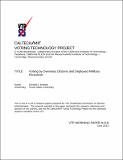Voting by Overseas Citizens and Deployed Military Personnel
Author(s)
Inbody, Donald S.
DownloadWP 119.pdf (307.8Kb)
Metadata
Show full item recordAbstract
The principal problem in serving overseas citizens and military voters is how best to return a marked ballot to local election officials. Prior to 2009, insufficient time was provided for an overseas voter’s ballot to be delivered and make it back in time to be counted. While the Uniformed and Overseas Citizens Absentee Voting Act (UOCAVA) of 1986 required all states, the District of Columbia, and U.S. territories to permit U.S. citizens abroad to register to vote and to vote by absentee ballot, it did not provide for uniform standards by which states must abide in ensuring overseas voters could exercise their vote.
The Military and Overseas Voter Empowerment (MOVE) Act of 2009 attempted to solve the problem by enacting four primary provisions:
+eliminating the requirement for notarization of overseas ballots.
+requiring all states to make voter registration at applications for absentee ballots available electronically along with a Federal Write-In Absentee Ballot (FWAB) in case the official ballots do not arrive in time.
+requiring overseas and military voters to re-register for each election cycle instead of every two election cycles.
+requiring all states to make provision to have ballots available for sending to overseas and military voters at least 45 days before the scheduled election day.
Date issued
2013-06Publisher
Caltech/MIT Voting Technology Project
Series/Report no.
VTP Working Paper Series;119